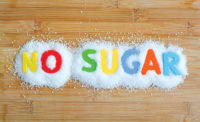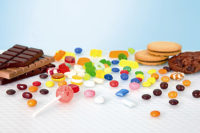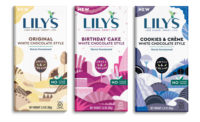The Sugar-Free Surge
By Renée Covino
As the desire to control sugar intake spreads from the
diabetic market to the general population, candy manufacturers respond
energetically.
The
“low” side of candy is hitting new heights. Even beyond
low-carb confections, those that are sugar-free or “dietetic”
have substantially surged. Between 2000 and 2004, U.S. sales of low-sugar
and low-fat candies quadrupled, according to a diet candy report released
late this summer by Packaged Facts, publishing division of
MarketResearch.com. Last year, consumers bought an estimated $495 million
in “diet” candy, compared with $118 million four years earlier,
according to the study. Packaged Facts defines diet candy as confections
that are low in sugar and/or carbs and/or calories.
Keeping track of this market through the latest IRI
numbers, the National Confectioners Association substantiates the Packaged
Facts growth findings. “Sugar-free and diet candy, not including gum,
has grown more than three-fold,” states Jim Corcoran, NCA’s
vice president of trade relations.
However, with sugarless gum added into the equation,
the $495 million diet candy market actually increases to about $1.2
billion. Sugarless gum is currently a $735 million category, according to
IRI dollar sales figures for the 52 weeks ending August 7, 2005.
“In 1997 the gum category was two-thirds regular
gum and one-third sugar-free; now that’s flipped,” says
Corcoran. For 2005, sugarless gum represents a little more than two-thirds
of the category.”
Even more proof of a category surge — launches
of reduced-sugar products have nearly tripled since 1999, according to
ProductScan Online.
Despite all this growth in sugar-free, the NCA still
recently referred to the category as an “untapped market.”
Is this possible? Are we just at the tip of
sugar-free? And will it continue to be a “go” for the future?
Industry and manufacturer response would certainly indicate a strong green
light. Here are some top category happenings pushing it in a positive
direction.
Artificial sweetener technology is a backing force. “The versatility of many artificial sweeteners allows
for manifold combinations to achieve just the right flavor, texture, and
appearance” in sugar-free candy, according to the Packaged Facts
report. “This synergy among ingredients provides a vast array of
choices for the American sweet tooth.”
In addition to what’s currently available in
no-calorie sweeteners (aspartame, sucralose, etc.) and reduced-calorie
sweeteners (polyols such as maltitose and isomalt), new
“natural” substitutes are predicted to have a positive
influence on the category as well, especially with the natural health
crowd. This includes the “legally” natural Shugr, on the market
since December 2004, and two new liquid blends, Rebalance System TM001 and
TM002, which are not yet in products on the market.
Other low-calorie sweeteners are on the horizon as
well (See sidebar on page 32.)
Innovation is also taking place with existing brand
sweeteners such as Splenda bringing even more consumer awareness to the
category. By October, consumers will have access to Splenda Brown Sugar
Blend, a blend of grown sugar and sucralose, delivering half the carbs and
calories of regular brown sugar, “but all of the taste, moistness and
functionality of regular brown sugar,” according to Monica Neufang,
spokesperson for the brand at McNeil Specialty Products Co.
“The concept of taking small steps to healthier
living is catching on,” Neufang reports. “Just 100 calories
less a day can have great impact on one’s overall health and
wellness.”
Sugar-free manufacturers are increasing production. Simply Lite Foods is one manufacturer that has always been
in the sugar-free confectionery business, but it has recently increased
“volume, variety and improved taste and textures,” according to
Gina Prescia, brand manager for the Commack, N.Y.-based company. “The
development of new, quality, functional ingredients has certainly played a
big part,” says Prescia. “We have added more production lines,
consisting of state-of-the-art equipment to increase the diversity and
capacity of our sugar-free/better-for-you production capabilities.”
For more than five years, Russell Stover has been a
driving force in the sugar-free chocolate category (and now owns the No. 1
market position by quite a margin, according to Information Resources
Inc.). And even with that status, the company continues to venture farther
out, believing in the category’s longevity.
“Our response to the consumer’s response
to our diet candy has been a vigorous introduction of new flavors, pack
types and ventures into non-chocolate as well,” says Mark Sesler,
vice president of product development for Russell Stover.
Strong non-sugar-free brands see the value in a
sugar-free counterpart. It seems like every
major brand in the candy arena now has a sugar-free counterpart. While
Russell Stover led the trend, Hershey is right behind it with its Hershey
brand, Reese’s brand, Pot Of Gold Brand and even the Twizzlers brand
all making IRI’s Top 20 list of the top-selling diet candy in both
the chocolate and non-chocolate categories for the 52 weeks ending August
7, 2005. Others on both lists include Nestlé Crunch, York Peppermint
Pattie, Nestlé Turtles, Life Savers, Crème Savers, Pearson
Nips, Jolly Rancher, Red Vines and Jelly Belly.
Many companies are now including comparison info on
their Websites so consumers can easily see the sugar and calorie savings.
For example, Jelly Belly reports that “by replacing sugar and corn
syrup in our recipes, our sugar-free candies have 30-55 percent fewer
calories per serving.” Like Hershey, Jelly Belly has spread the
sugar-free application across many of its offerings. In addition to a
sugar-free Jelly Belly jelly beans 10-flavor mix and five-flavor sours mix,
the company offers sugar-free gummi bears, inchworms, fruit slices, spice
drops, cola bottles and fruit drops.
Low-carb is quickly switching gears to sugar-free. At least that’s the word from players like
Asher’s Chocolates. According to company president, Jack Asher,
“The FDA was very late in coming out with what they declared was
low-carb — so now that the trend has waned, a lot of us got stuck
with that labeling.”
Asher’s has already relabeled its
“low-carb” chocolate bars to be “low-sugar”
chocolate bars, hitting the market right after Labor Day.
One key point in all this is that sugar-free has come
to be viewed as a part of a more health-conscious eating plan and not
simply a fad. Nor is it seen as merely something that meets the needs of an
increasing diabetic population. “As Americans become more
health-conscious, specifically in food education, the
sugar-free/better-for-you category will continue to grow,” believes
Prescia.
Sesler agrees that “to say the sugar-free market
grows only as fast as the population with diabetes grows is a limited
perspective. The growing concern with obesity, the greater awareness of
eating more healthfully, the growth of both types of diabetes, the overall
aging of the population, and good to great-tasting new products will
continue to fuel the growth in the sugar-free category.”
There are some challenges, however. There are obstacles in sugar-free that need to be overcome,
say industry players, “particularly the laxative effects,”
according to Prescia. She is referring mostly to the polyols
reduced-calories sweeteners that for some can cause gastrointestinal
symptoms, such as gas or laxative effects, similar to reactions to beans
and certain high-fiber foods.
While there are many nutritionists who champion
artificial sweeteners as a way to cut calories and reduce sugar, there are
also those who say that they are not the answer to America’s weight
and health problems. Some critics have voiced concerns about the increased
consumption of what they refer to as “chemical” sweeteners,
especially among children.
For instance, The New York Times recently quoted Dr.
Susan Schiffman, a sweetener specialist and professor of medical psychology
at Duke University Medical Center, who admitted she has “safety
concerns” about sucralose. Other nutritionists have observed that
people who consume a lot of artificially sweetened foods also end up eating
an excess of foods loaded with regular sugar, negating any calorie or
health savings.
Customer confusion has also been reported with
low-sugar products and confections that are not necessarily low in
calories.
The GI Factor
As the low carb craze wanes, the next chapter in
diet/nutrition is believed to be the glycemic index, a scientific ranking
that classifies foods based on how quickly they raise blood sugar.
According to “The G.I. Diet” author Rick Gallop, the secret to
losing pounds is avoiding foods that cause blood sugar levels to rise sky
high. Such foods trigger a release of insulin, promoting fat storage and
causing a quick return of hunger, believes Gallop, past president of the
Heart and Stroke Foundation of Ontario.
Recently-developed additives are catering to the GI
concept. Palatinose, also known generically as isomaltulose, is a unique
sugar/functional carbohydrate from Palatinit, being touted as a
"healthy" sugar that "can help reduce the glycemic and
insulin response of foods." Recently, Palatinose, which has
self-affirmed GRAS status in the United States, was approved by the
European Commission for use in the European Union (EU) in all foods and
beverages.
The United Nation’s World Health Organization is
just one group that has embraced the GI concept; Australia and South Africa
have even allowed glycemic index on food labeling. But in this country
there are skeptics — American scientists have not yet agreed on the
GI’s validity.
Basically, the dispute is whether or not the glycemic
index can be trusted as a tool to help control appetite, weight, obesity,
diabetes, and other health concerns, according to panelists at the
Institute of Food Technologists (IFT) annual meeting this past July.
At this point, the conclusion is that the GI is a
“moving target;” published values of specific foods can vary up
to 25 percent, a range that scientists consider unacceptable in most
arenas, noted Kathie Wrick on the IFT panel, and a partner with the Food
Group, a food consultancy firm. It was also noted that GI values can vary
widely from person to person. Further complicating the issue — the
measure can be affected by factors such as serving size, the amount of
processing and preparation, even ripeness or serving temperature.
So where does that leave the United States on the
issue? No major American health organization has yet to recognize the GI in
disease prevention or management, and because of this, Wrick believes the
U.S. Food and Drug Administration may be slow to take a stance on GI food
labeling.
Nevertheless, “consumers are ready for the
glycemic index, and we have to respond because products are going to be
developed around this concept,” said Linda Douglas, on the IFT panel,
and scientific affairs manager for GTC Nutrition. Low- and no-sugar candies
will no doubt be a part of this group.
The Low-Down on Low-Cal Sweeteners
Variety is a sweet thing. The current availability of
a multitude of low-calorie sweeteners allows candy manufacturers to utilize
a “multiple sweetener approach” — using the most
appropriate sweetener, or combination of sweeteners, for any given
confection, providing products with increased stability, improved taste,
lower production costs and more choices for the consumer.
Low-Calorie Sweeteners Currently Used in the United
States
Acesulfame Potassium (Acesulfame K). Invented in 1967, it was granted general approval in the
U.S. in 2003 for use in a variety of confectionery products including
chewing gum, dry dessert mixes, soft candy, hard candy and breath mints.
Aspartame. Invented
in 1965, aspartame is approximately 200 times sweeter than sucrose. It is
one of the most thoroughly studied food ingredients ever, with more than
200 scientific studies confirming its safety. In 1981 aspartame was
approved for use, making it the first low-calorie sweetener approved by the
FDA in more than 25 years.
Neotame. A no-calorie
sweetener, which is a derivative of the dipeptide composed of the amino
acids, aspartic acid and phenylalanine. It is approximately 30-40 times
sweeter than aspartame; 7,000-13,000 times sweeter than sugar. The FDA
approved the use of neotame as a general purpose sweetener in July 2002.
Saccharin. Saccharin has
been used to sweeten foods and beverages without calories or carbohydrates
for over a century. In 1991, the FDA formally withdrew its 1977 proposal to
ban the use of saccharin.
Sucralose. Sucralose
(available under the Splenda brand name) is the only non-caloric sweetener
made from sugar. Invented in 1976, sucralose was granted approval by the
FDA in 1998 for use in 15 food and beverage categories — the broadest
initial food ingredient approval ever granted by the FDA. In 1999 it was
approved as a "general purpose" sweetener.
Low-Calorie Sweeteners on the Horizon
Alitame. Invented by
Pfizer, Inc., alitame (brand name Aclame) is a sweetener formed from the
amino acids L-aspartic acid and D-alanine, and a novel amine; it is 2,000
times sweeter than sucrose.
Cyclamate. A
non-caloric sweetener discovered in 1937, it is 30 times sweeter than
sucrose. It is stable in heat and cold and has good shelf life. Banned in
the U.S. in 1970, there is currently a petition before the FDA for
re-approval.
Reduced-Calorie Sweeteners
Polyols. Carbohydrates
and not sugars, polyols are used volume-for-volume in the same amount as
sugar. Often referred to as "sugar replacers" with consumers and
sugar alcohols with scientists, they are neither sugars nor alcohols.
Polyols currently in use in the U.S. are: erythritol, hydrogenated
starch hydrolysates (including maltitol syrups), isomalt, lactitol,
maltitol, mannitol, sorbitol and xylitol. They provide fewer calories per
gram than sugar, do not cause sudden increases in blood glucose levels, but
excessive consumption may cause gastrointestinal symptoms.
Tagatose. A low
carbohydrate functional sweetener, very similar to fructose in structure.
The FDA has granted “Generally Recognized as Safe” (GRAS)
status.
Trehalose. A
multi-functional sweetener found naturally in foods such as mushrooms and
shrimp. The commercial product is made from starch by an enzymatic process.
It may be used in nutrition bars and white chocolate for cookies or chips,
among others. It has GRAS status.
Source: Calorie Control Council; (http:
//caloriecontrolcouncil.org)




